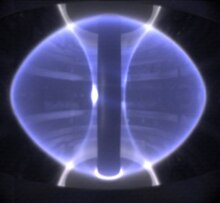
A spherical tokamak is a type of fusion power device based on the tokamak principle. It is notable for its very narrow profile, or aspect ratio. A traditional tokamak has a toroidal confinement area that gives it an overall shape similar to a donut, complete with a large hole in the middle. The spherical tokamak reduces the size of the hole as much as possible, resulting in a plasma shape that is almost spherical, often compared to a cored apple. The spherical tokamak is sometimes referred to as a spherical torus and often shortened to ST.
The spherical tokamak is an offshoot of the conventional tokamak design. Proponents claim that it has a number of substantial practical advantages over these devices. For this reason the ST has generated considerable interest since the late 1980s. However, development remains effectively one generation behind traditional tokamak efforts like JET. Major experiments in the ST field include the pioneering START and MAST at Culham in the UK, the US's NSTX-U and Russian Globus-M.
Research has investigated whether spherical tokamaks are a route to lower cost reactors. Further research is needed to better understand how such devices scale. Even in the event that STs do not lead to lower cost approaches to power generation, they are still lower cost in general; this makes them attractive devices for studying plasma physics, or as high-energy neutron sources.
© MMXXIII Rich X Search. We shall prevail. All rights reserved. Rich X Search
